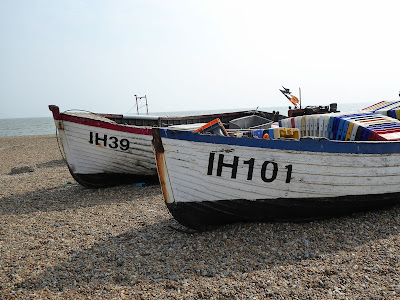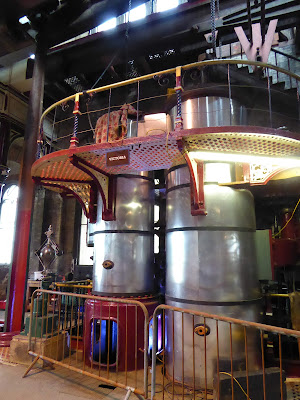
Last week I went away for a few days to the county of Suffolk in East Anglia. It's just a couple of hours from London by car but I haven't visited it that often and there are a few places I wanted to see. My first stopping place was Sutton Hoo. If any of you have seen the film 'The Dig' with Ralph Fiennes then you might be familiar with the name Sutton Hoo.
Hoo derives from an Old English word for a piece of land that sharply projects into a valley. The film is a true story about the 1930s land owner, Edith Pretty, who hires an amateur archaeologist to investigate large mounds of earth on her property. What he discovered turned out to be one of the biggest finds in the history of England and beyond.


It was in one of these mounds that the ghost of a burial ship was found. After Brown had excavated some of the smaller mounds and discovered that they had been robbed by treasure seekers he didn't hold out much hope of finding anything. In May 1939 he decided to excavate one of the larger mounds and discovered five rivets in position in what turned out to be the extreme stern or prow of a ship.
Sutton Hoo's Great Ship Burial contained an impressive 27m long ship with space for 40 oarsmen. Signs of repair showed that the ship had made many journeys before it was hauled up from the river to its resting place here in the King Raedwald's grave. During the 14 centuries it remained hidden in the soil, the wood rotted leaving just the iron rivets behind and the trace of a ship. The ship weighed approximately ten tonnes and measured 27 metres.
It had been carried up hill from the river and then buried with the late king and a collection of precious items befitting a king. It was in this part of East Anglia that the Anglo-Saxons interred their dead kings during the 6th and 7th centuries.
This sculpture is a full scale representation of the ship.
This view from the 17 metre tall viewing tower shows the River Deben in the distance where the ship would have been hauled out of the river and up the hillside.

Once it became obvious that this was an important archaeological site, experts were called in from Cambridge University. In all there were 263 finds of gold, garnet, silver, bronze, enamel and so on. Some were as bright as if they had just been buried whilst others were broken and corroded. Due to the imminent outbreak of war it was a race against time to excavate as much as possible before they had to refill the excavated area and prepare for war. The finds were packed away in anything they could get their hands on such as boxes and tins from the local shops. Edith donated the find to the nation in the care of the British Museum.

This is a reconstruction of the King's Helmet. The helmet was a challenge to reconstruct as only the nose, eyebrows and helmet crest were in one piece. The rest of the helmet had been crushed into 100 pieces when the burial chamber had collapsed. The original pieces form part of the reconstruction in the British Museum where all the treasure from the find is held.
Other reconstructed pieces in the Sutton Hoo exhibition include this shield.
A shoulder clasp.
The warrior horseman found in another grave was buried with his horse's harness. It was made of gilded bronze which was decorated with faces and animals. The grave of the warrior was laid out next to one for his horse.
This pendant was made from a 200 year old Roman gold coin depicting the Western Roman Emperor Honorius who ruled between 395 and 423AD.
An antler comb
This is one of ten silver bowls buried with the king.
It wasn't until the 1960s that further explorations of the area took place. Much of this investigative work led to further information about what had happened to the king's body as well as other bodies. Chemical analysis showed that they had decomposed because of the acidic make up of the soil. No more artefacts have been found but much more still needs to be excavated and researched. I now need to make a visit to the British Museum and have a look at the actual treasure found at Sutton Hoo.
Sharing with Our World Tuesday




































































